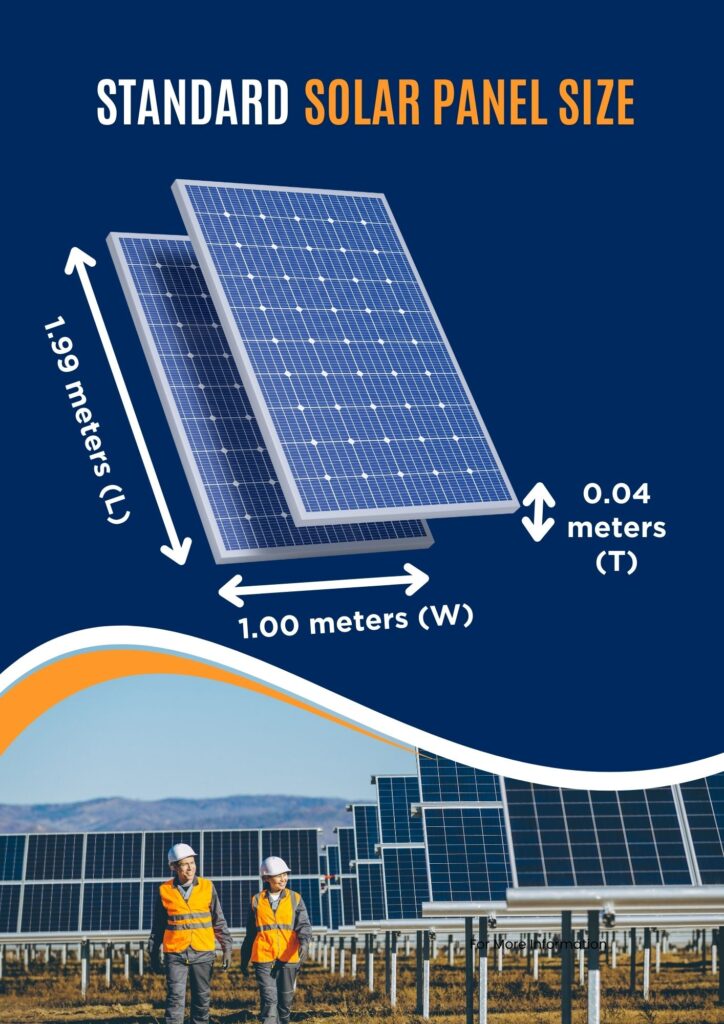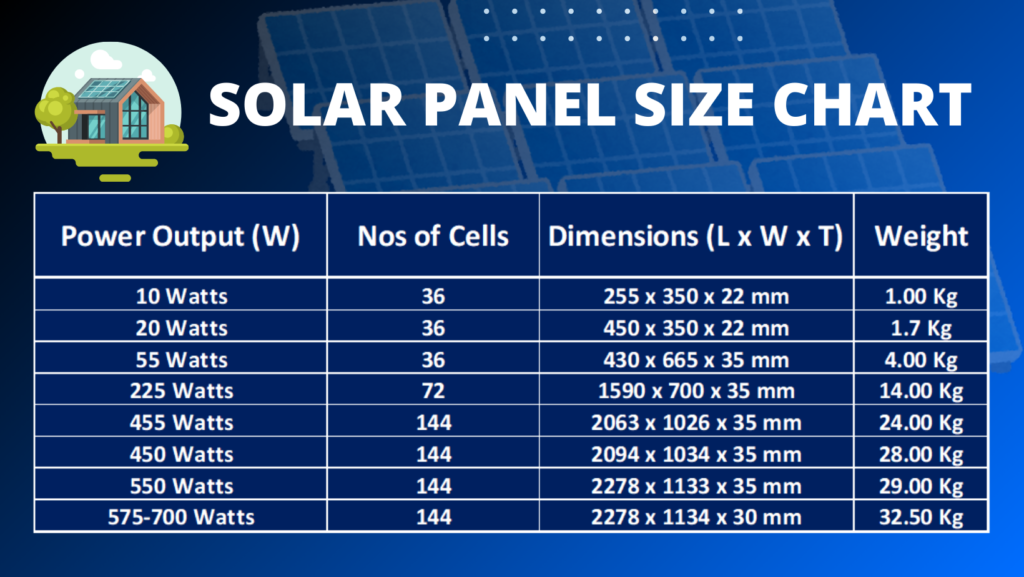Are you also thinking about installing solar panels at your home, office, or business premises? If so, you probably have questions about the size, dimensions, and wattage of solar panels. You’re in exactly the right place—this blog post will give you complete information on the size, dimensions, and wattage of solar panels.
Let me explain: the size of a solar panel is measured in terms of its length, width, and height (thickness) typically in centimeters and feet, while the area of the panel is measured in square meters or square feet. Apart from physical measurements, a panel’s energy output, or wattage (measured in watts, W), is also essential in making an informed decision about installing solar panels.
A solar panel is made up of small photovoltaic cells, which can number 32, 36, 48, 60, 72, 96, 132, or 144 in each panel. These photovoltaic cells are arranged in a frame, making the panel either rectangular or square in shape. As the number of photovoltaic cells increases, the panel’s size, dimensions, and wattage also increase.
Now, let’s take a closer look at the size, dimensions, and wattage of solar panels one by one.
Standard Solar Panel Size
The size of a solar panel primarily depends on its type of use, such as residential, commercial, or industrial applications. Additionally, the brand of the solar panel and its output wattage also influence its size. The size of a single solar cell is approximately 189 x 100 x 3.99 centimeters, which contributes to the overall dimensions and power capacity of the panel.
Typically, a standard residential solar panel measures around 1.99 meters (L) x 1.00 meters (W) x 0.04 meters (T), with a total area of approximately 1.99 square meters and provides a power output of about 335 watts. Similarly, the standard size for a solar panel used in commercial or industrial settings is 1.27 meters (L) x 1.13 meters (W) x 0.04 meters (T), with a total area of about 2.57 square meters and delivers a power output of around 575 watts. Both types of panels contain 72 cells or 144 half-cut cells.

Solar Panel Size Chart
When choosing a solar panel, understanding the different sizes and specifications is key. Solar panels vary in dimensions, power output, weight, and the number of cells they contain. These factors influence where panels can be installed, how much energy they produce, and their suitability for residential, commercial, or industrial applications. Below is a comprehensive size chart for various solar panels, detailing the power output, number of cells, dimensions, and weight for each type. This chart will guide you in selecting the right panel to match your specific energy needs and space requirements.
| Power Output (W) | Number of Cells | Dimensions (L x W x T) | Weight |
|---|---|---|---|
| 10 Watts | 36 | 255 x 350 x 22 mm | 1.00 Kg |
| 20 Watts | 36 | 450 x 350 x 22 mm | 1.7 Kg |
| 55 Watts | 36 | 430 x 665 x 35 mm | 4.00 Kg |
| 225 Watts | 72 | 1590 x 700 x 35 mm | 14.00 Kg |
| 455 Watts | 144 | 2063 x 1026 x 35 mm | 24.00 Kg |
| 450 Watts | 144 | 2094 x 1034 x 35 mm | 28.00 Kg |
| 550 Watts | 144 | 2278 x 1133 x 35 mm | 29.00 Kg |
| 575-700 Watts | 144 | 2278 x 1134 x 30 mm | 32.50 Kg |
This chart provides a quick reference to help you determine the right solar panel size for your project, balancing energy production with available space and installation requirements. Whether you need a compact panel for small-scale use or a larger, high-output panel for extensive energy demands, the size chart above offers valuable insight into each panel type.

How solar panel size and dimensions affects the system design
The size and dimensions of solar panels are crucial and important factor factors in the design of any solar power system. Here are some important factors related to size and dimensions that affects the system design.
- Space Requirements: The height and width of solar panel will determine the required area to install the solar panel. Larger panels need more roof or ground space. Before installation, it’s essential to measure the available area to ensure the panels will fit and receive adequate sunlight. as per the size and dimensions you need to required shadow free are to install solar power system.
- Power Output: The power output or wattage of a solar panel depends on its size and dimensions. As the required power output increases, the panel’s size and dimensions typically increase as well. Additionally, achieving higher output may require increasing the number of solar panels in the system.
- System Layout: The size and dimensions of solar panels determine the overall layout of the solar power system, which enhances the performance of the panels. Measuring the right panel size and dimensions helps create a more efficient and effective layout for the solar power plant.
- Efficiency in Wiring and Energy Flow: As the size and dimensions of solar panels increase, their power output (wattage) also rises. This reduces the required number of panels in a solar power plant, simplifying wiring and decreasing the likelihood of energy loss. With reduced wiring, energy flows more efficiently, leading to improved overall performance of the solar power plant.
- Cost of Solar Power System: As the size and dimensions of solar panels increase, their cost also rises. However, larger solar panels produce more energy and are relatively easier to maintain. As a result, the maintenance and upkeep costs of larger panels are lower compared to smaller panels.
How to find the best solar panel size and dimensions ?
The easiest way to determine the size and dimensions of solar panels before installing a solar power system is to consult a solar panel installation expert. This expert will assess your energy consumption needs, available shade-free space, and the amount of sunlight that reaches the area to choose the appropriate size and dimensions for your solar panels. The solar panel installation expert will select panels that fit your available space and meet your electricity requirements efficiently.
The Importance of Solar Panel Size and Dimensions for Efficiency
The dimensions of solar panels can impact efficiency, affecting the system’s overall energy yield and cost-effectiveness:
- Direct Sunlight Capture: As you know, the larger the size and dimensions of a solar panel, the greater its surface area will be. This increased surface area allows larger solar panels to capture more sunlight, resulting in a higher energy output and increased electricity generation.
- Panel Orientation and Tilt: When installing larger solar panels, the positioning and tilt must be measured with great precision. Due to their larger size, the correct orientation and angle cannot be determined simply by visual inspection from above. Therefore, it is essential to use the proper tools to accurately measure and install the panels.
- Energy Density: Smaller solar panels are typically suitable only for residential use. When it comes to higher energy production, larger solar panels are preferred due to their greater energy efficiency. For commercial or industrial applications, only large-sized solar panels are used.
Which solar panel installation size and dimensions is the best for you?
The best solar panel installation size and dimensions for you depends on several factors:
- Energy Consumption and Goals: First, you need to assess your average energy consumption. If your daily energy usage is low, you can opt for smaller-sized solar panels. However, if your electricity consumption is high and you wish to rely entirely on the electricity generated by solar panels, it would be more appropriate to choose larger-sized solar panels.
- Available Space and Sunlight Exposure : When installing solar panels, the most important factor to consider is the amount of shade-free area available, as maximum efficiency and energy production can only be achieved in such spaces. The larger the shade-free area, the larger the size and dimensions of the solar panels you can install. Additionally, if your location receives abundant sunlight throughout the year, you can opt for a smaller system. However, areas with limited sunlight may require larger systems to meet energy needs.
- Budget Availability: Consider your budget first, as larger systems generally have a higher upfront cost but provide greater savings in the long run. As the size and dimensions of solar panels increase, their cost also rises. However, larger solar panels produce more energy and are relatively easier to maintain, leading to lower maintenance and upkeep costs compared to smaller panels.
Selecting the right size and dimensions of solar panels is essential to ensuring the efficiency, cost-effectiveness, and long-term performance of your solar power system. By carefully evaluating factors like energy consumption, available space, sunlight exposure, and your budget, you can choose the most suitable panels for your needs. Larger panels may have a higher upfront cost, but they generate more energy, require less maintenance, and offer greater long-term savings. Consulting with a solar panel installation expert can help you to find the best solar panel size and dimensions, ensuring optimal energy production and a sustainable investment for the future.



Pingback: Types of Solar Panels: Which One is Best for Your Home in 2025 - Ranotech Solar Jankari